-
Car Reviews
- All reviews
- Midsize SUVs
- Small cars
- Utes
- Small SUVs
- Large SUVs
- Large cars
- Sports SUVs
- Sports cars
- Vans
Latest reviews
- Car News
-
Car Comparisons
Latest comparisons
- Chasing Deals
The Noosa Hill Climb is regarded by many as Australia’s toughest and least forgiving. We brought along a Hyundai i20N to try a bit of giant-killing
Lift-off oversteer’s a wonderful, joy bringing thing…. until it isn’t. I’m on cold tyres, coming through Turn 3 at Noosa’s unforgiving Hill Climb, and my Hyundai i20 N’s suddenly at an angle only Sebastien Loeb-types enjoy.
The view through my windscreen is straight into trees – not ideal – while the little i20N’s spoilered rump is perilously close to concrete blocks lining the corner’s outside edge.
The i20N’s in maximum attack N Mode with its stability control (ESC) safety net turned off, but, weirdly, I’m not overly concerned. It’s why I love this car.
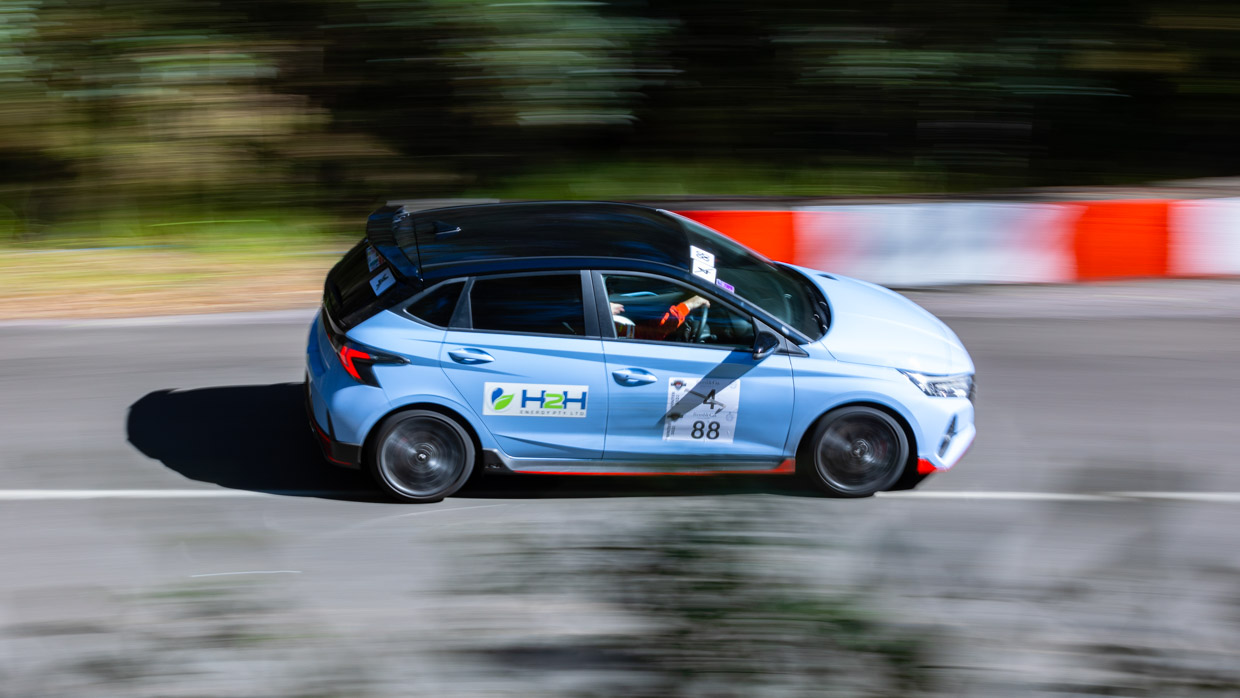
I realise I’ve over-estimated grip levels on cold Pirelli P Zero rubber, but the baby Hyundai’s given plenty of warning we’re about to have a ‘moment’.
Opposite lock engaged, back on the throttle and all’s rosy once more, aside from the lost momentum stuffing my timed run. Dammit.
That’s the thing with the little Hyundai i20N. A bond of trust is established early in your relationship with one. It loves a fast corner as much as you do, and its incredibly smart front diff will pull the nose right into a corner apex, if you keep the faith with your right foot.
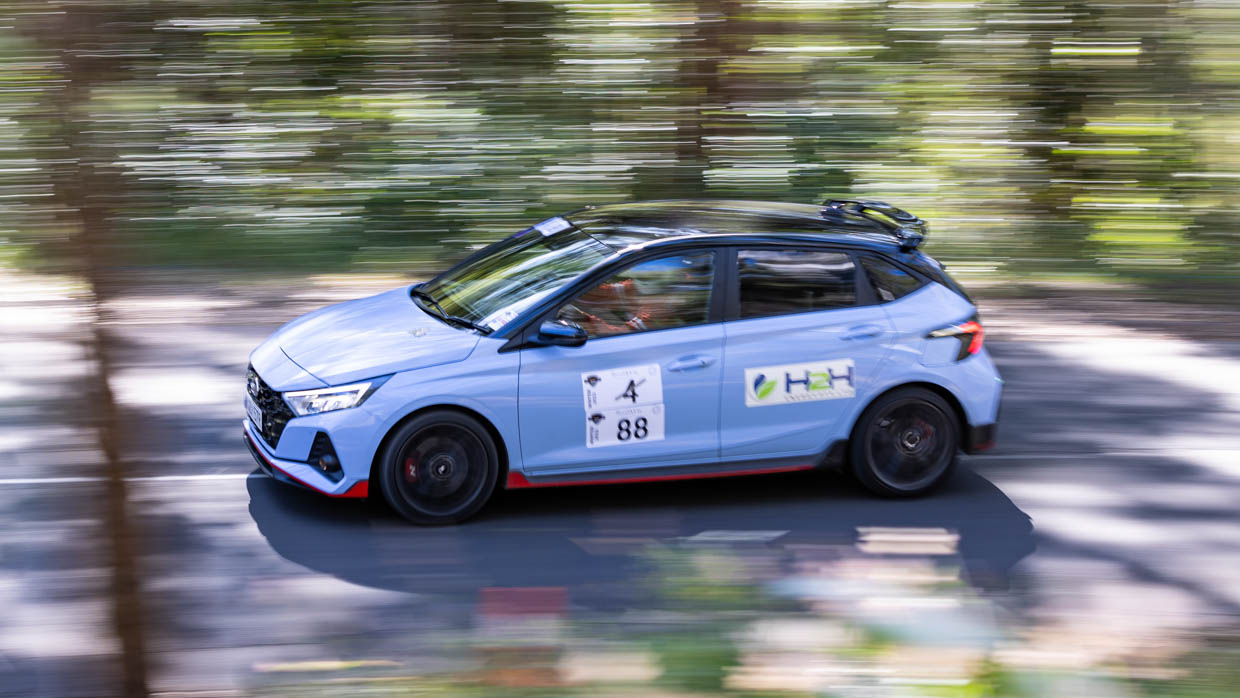
It’s a cliché, but it’s a car that’s on your side. Its epic traction and the way the chassis communicates so clearly through your backside means it wills you to properly test its and your own abilities.
Which is why, if you own one, you must take it to a track. Or, like us, enter it in a hill climb.
At Chasing Cars, we’re no stranger to the Hyundai i20N’s charms.
Ponch’s launch review declared it a “feisty, fun-loving, involving hot hatch,” while John Law had the privilege of running one for a six-month long-term review.
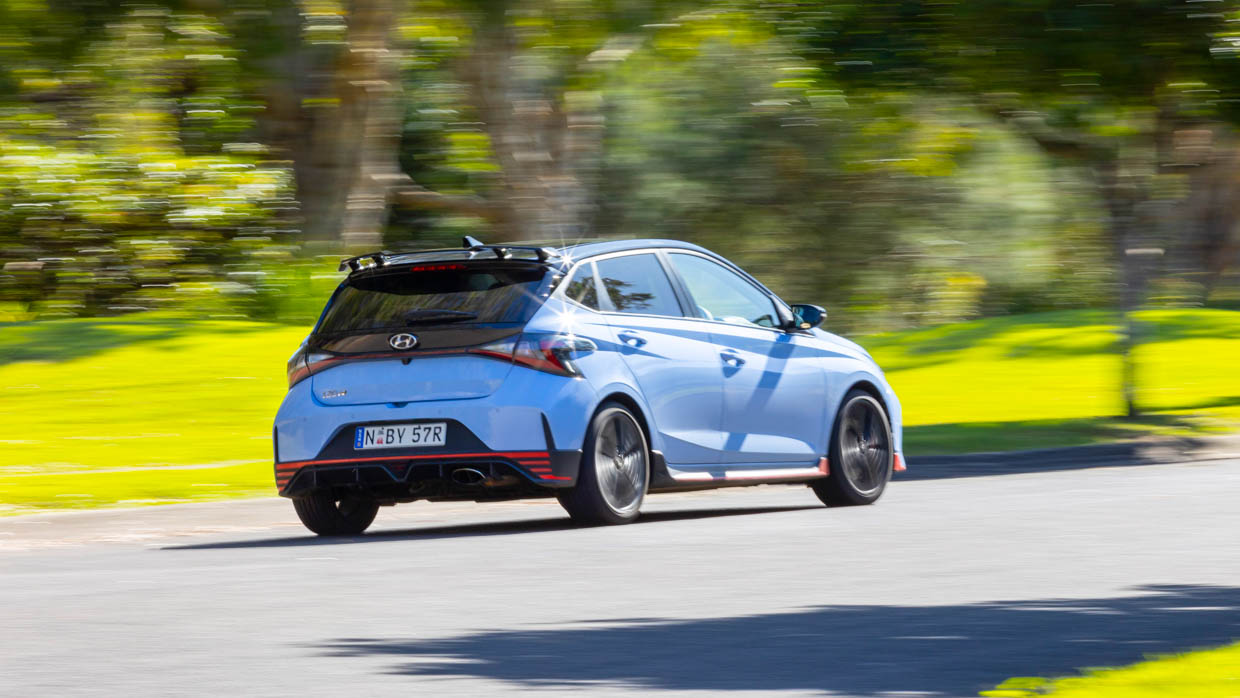
Both are ideal reads for those considering an i20N as a daily driver/weekend toy, where you’ll learn about its rapid tyre wear, regular oil changes and challenging ride comfort as a daily. You know, the boring stuff.
I’ll swerve such sensibles. This is a test of the fizzing little Korean in its element. An against-the-clock hill climb over a challenging twisty snake of corners.
Spoiler alert: this diminutive hot hatch is a giant killer, embarrassing far more powerful and expensive machinery. And it does so without the driver having to risk ten-tenths.
Hyundai actively promotes its N buyers to hit the racetrack, best evidenced with its hugely popular N Festivals. The car’s five-year warranty extends to track use, as long as it’s not timed.
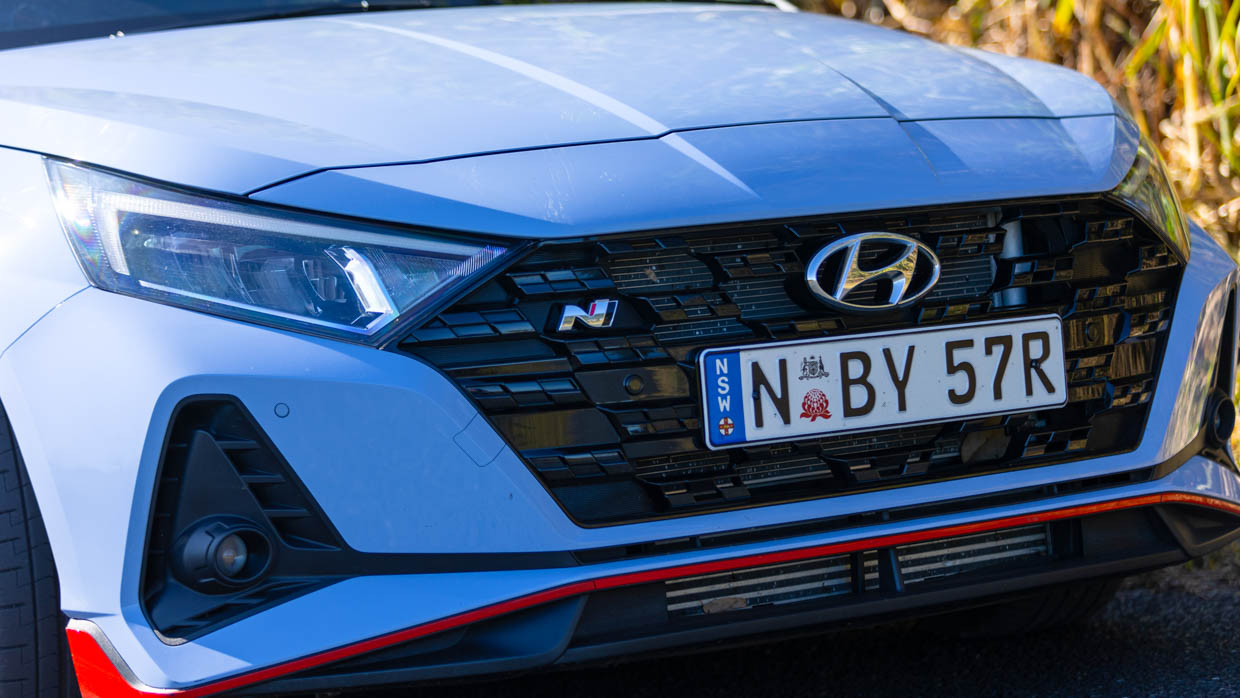
Okay, so that means if you blow an engine or smoke a clutch at an against-the-clock event like Noosa, you’re on your own. But doing the event doesn’t void your warranty forever more, only if the failure happens at the race event. As an owner, I’d be happy with that.
It’s a bloody bargain, too. I know that $34,990 isn’t an insignificant sum, but in the grand scheme of things, if you’re going to risk a newish car in grassroots motorsport, the i20N’s asking price pales next to something like a Porsche 911 GT3 RS.
Unless you buy specific track insurance (not cheap), you’re not covered if you have a bingle in a timed event like the Noosa Hill Climb. Even so, the entry list here is usually chockers with big ticket stuff.
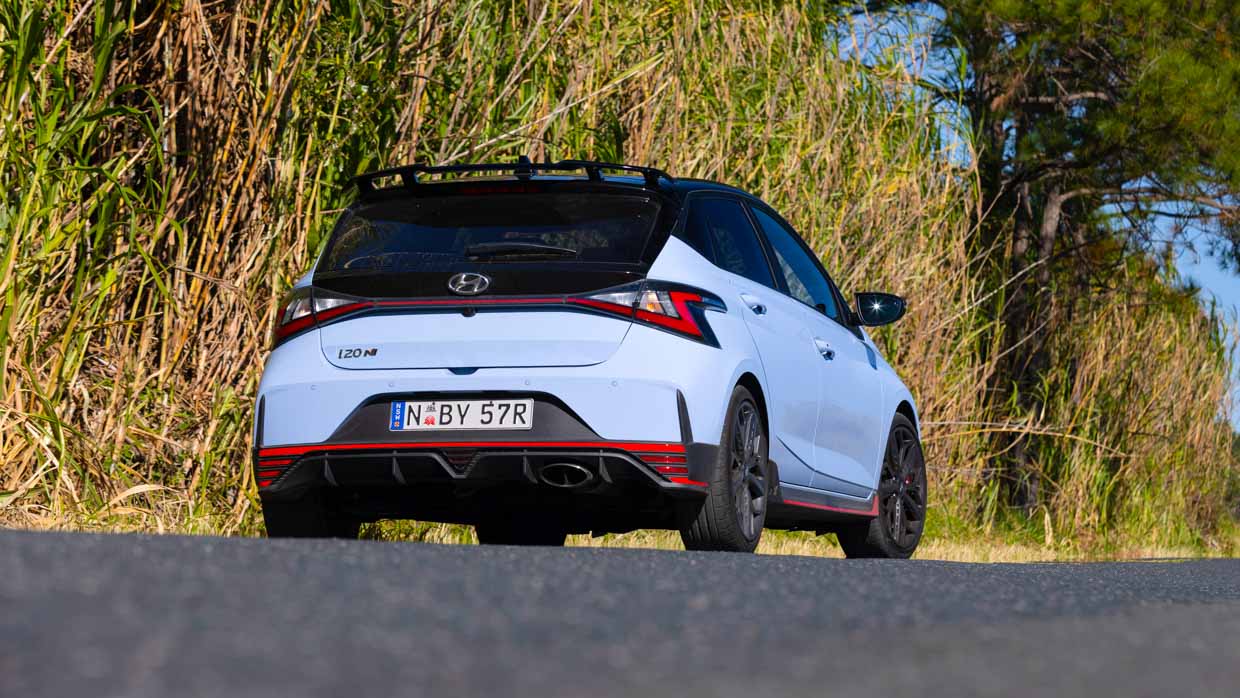
Supercars ace Fabian Coulthard was in one of two 911 GT3 RSs, there was an Audi RS5, BMW M2 Competition and Nissan GT-R, plus some high-value classics: cars you really don’t want to take to a smash repairer without a stuffed wallet.
A Toyota GR Yaris aside, Hyundai’s i20N is close to the ideal choice for this timed hill climb. Being light, stiff, nimble and with a responsive turbo engine works wonders here.
Big Mustangs and Commodores sound spectacular, but are hulking great things to hustle up Noosa, and proper handfuls when it’s wet.
The course is 1.5km and 14 turns of twisty blacktop through Queensland State Forest. The surface is a bumpy mess in places, and there’s perilously little room for error.
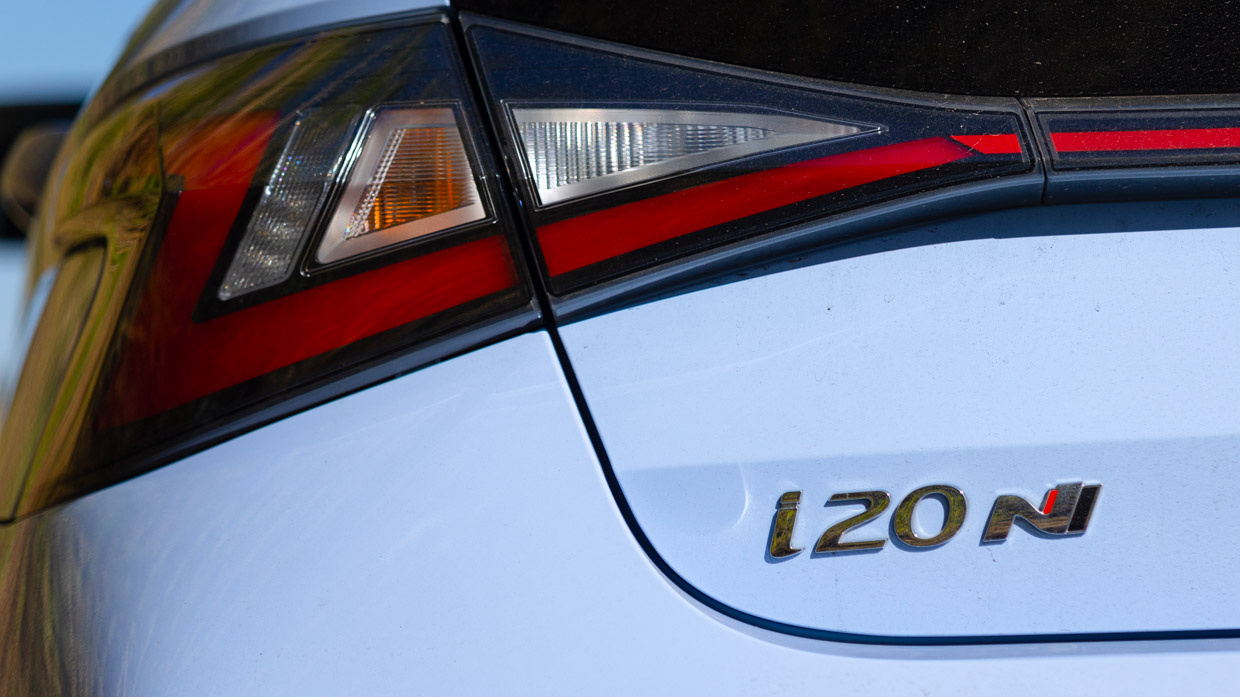
I’ve seen cars go into solid banks, off into trees, inverted after clipping a tyre barrier and – worst of all – straight into giant concrete blocks. The car never wins in these cases.
Trust is everything, which is why the i20N shines. I used to race my 1989 Peugeot 205 GTI at Noosa, until a muddy, wet track and those concrete blocks forced it into early, bent metal retirement.
How can we not do some name dropping? I shared the i20N entry with my old racing mate Cranston Polson, and we manage second and third in class in the little Hyundai.
Behind us in the overall standings are a Lotus Exige, Toyota GR Yaris, VW Golf R, Mercedes AMG A45, BMW M2 and a couple of Ford Focus RSs. Decent confirmed kills for a Korean hot hatch in a totally different price bracket.

Pictured: reviewer Iain Curry (right) alongside fellow driver, and good mate, Cranston Polson (left)
You’re divided into classes based on type of car, engine capacity and being two- or all-wheel drive. Anyone who has competed in such events know how very difficult (and often argue-inducing) it is classifying each vehicle.
For one, if your engine’s turbocharged, its capacity is multiplied by 1.7. So the i20N with its 150kW/275Nm boosted 1.6-litre four-cylinder ends up in the 1900cc – 3000cc Street class.
Our class includes a 950kg Alfa Romeo GT Junior stripped and caged race car (it had license plates, to be fair), a Mini Cooper, Subaru BRZ, Mazda RX8 and a 1974 Porsche 911 RSR replica.
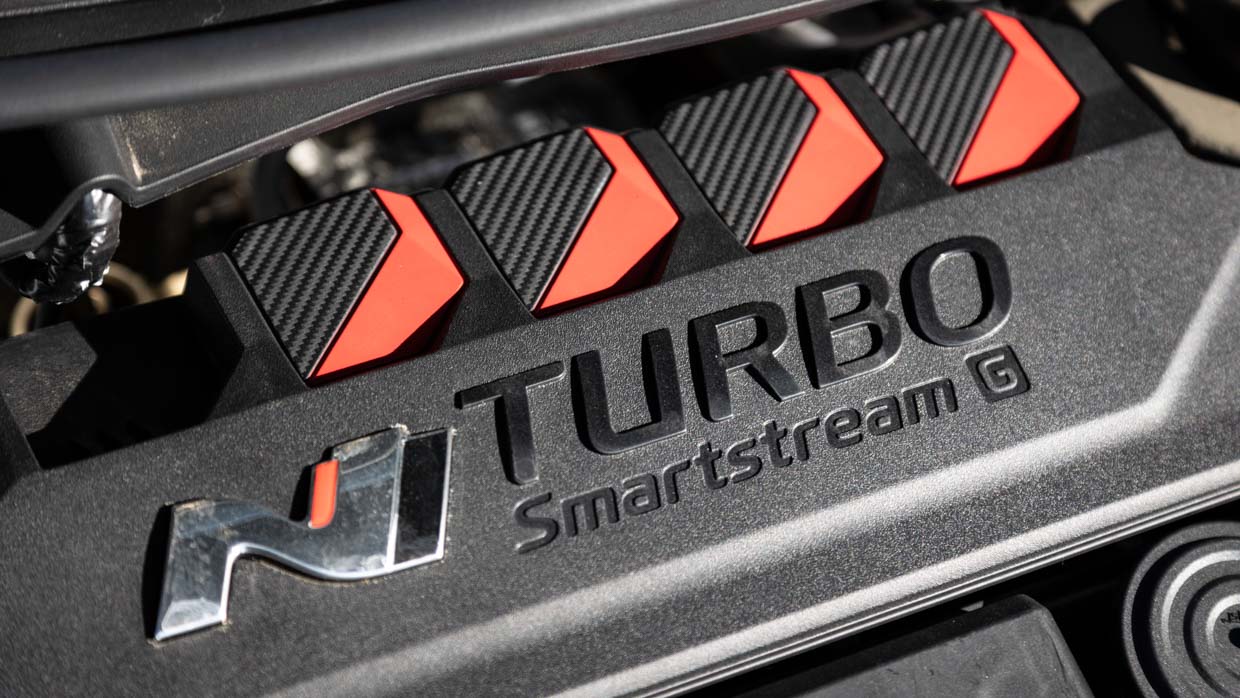
A mixed bag indeed (an AWD GR Yaris also somehow crept in), and it was only that pesky Alfa that my co-driver and I couldn’t catch. Its driver could steer a bit.
Impressively, our i20N is totally ‘out of the box’ with no modifications needed. We play around with tyre pressures, but it makes little difference.
Unlike a track day where you can warm your tyres up before going flat-chat, this Hill Climb’s over in under 70 seconds, so as soon as the rubber starts heating up, it’s all over.
It’s just bloody good fun, and isn’t that the way it should be?
For starters you’re held in by sculpted racing seats, sitting really low and with a meaty steering wheel, although personally I’d prefer a smaller one.
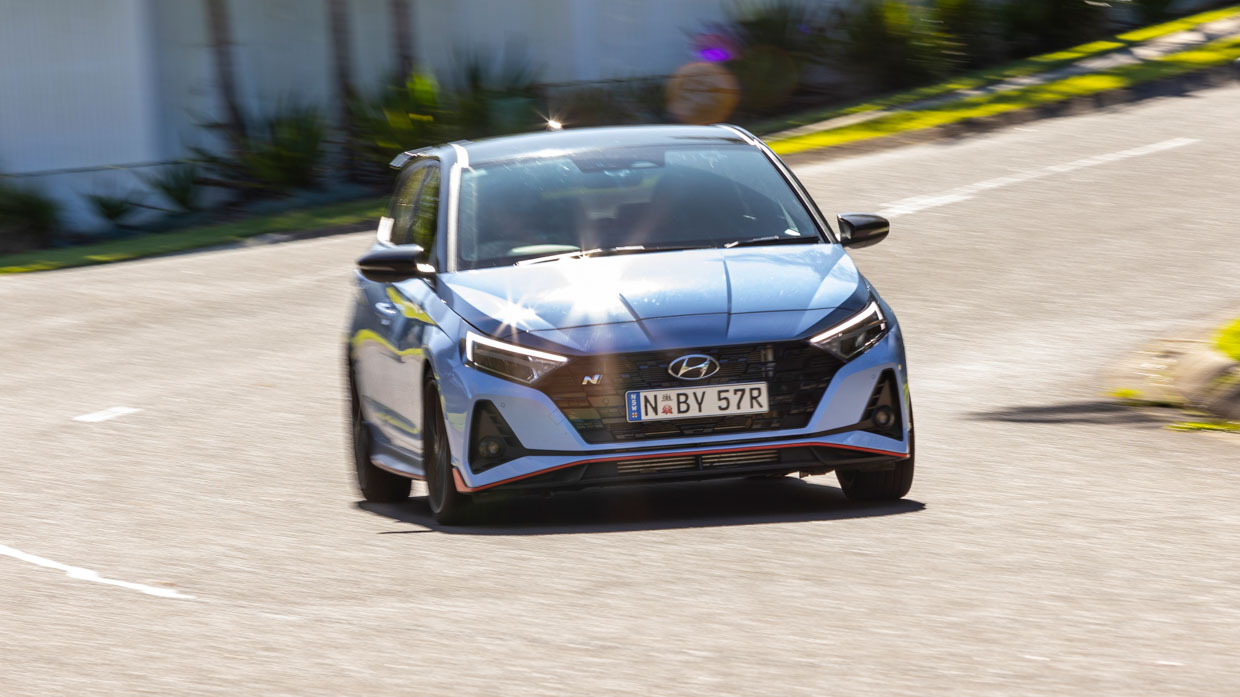
It’s an excellent, race-like driving position and the metal pedals are well spaced for heel-toe shenanigans. There’s a cheaty rev-matching button to use if the latter’s not your thing.
The digital dashboard goes all racy when you go through drive modes, including a firey graphic around the tacho when you hit the N Mode button.
I’d normally find this intolerably cheesy, but the i20N’s so charmed me I end up liking it.
The infotainment screen houses all your race day vitals. It’s a decent-sized 10.25 widescreen showing a lap timer, G-force monitor, throttle percent, brake pressure percent, tyre pressures and temperature vitals. Hyundai properly knows what track day types want at their fingertips.
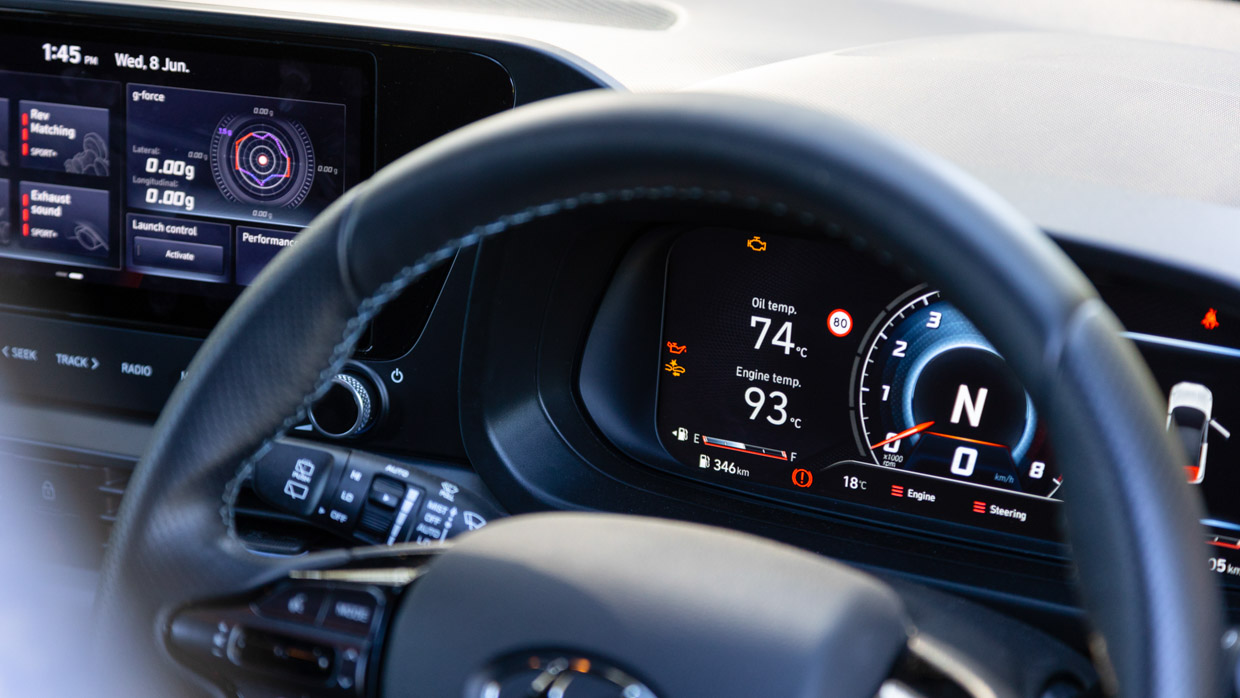
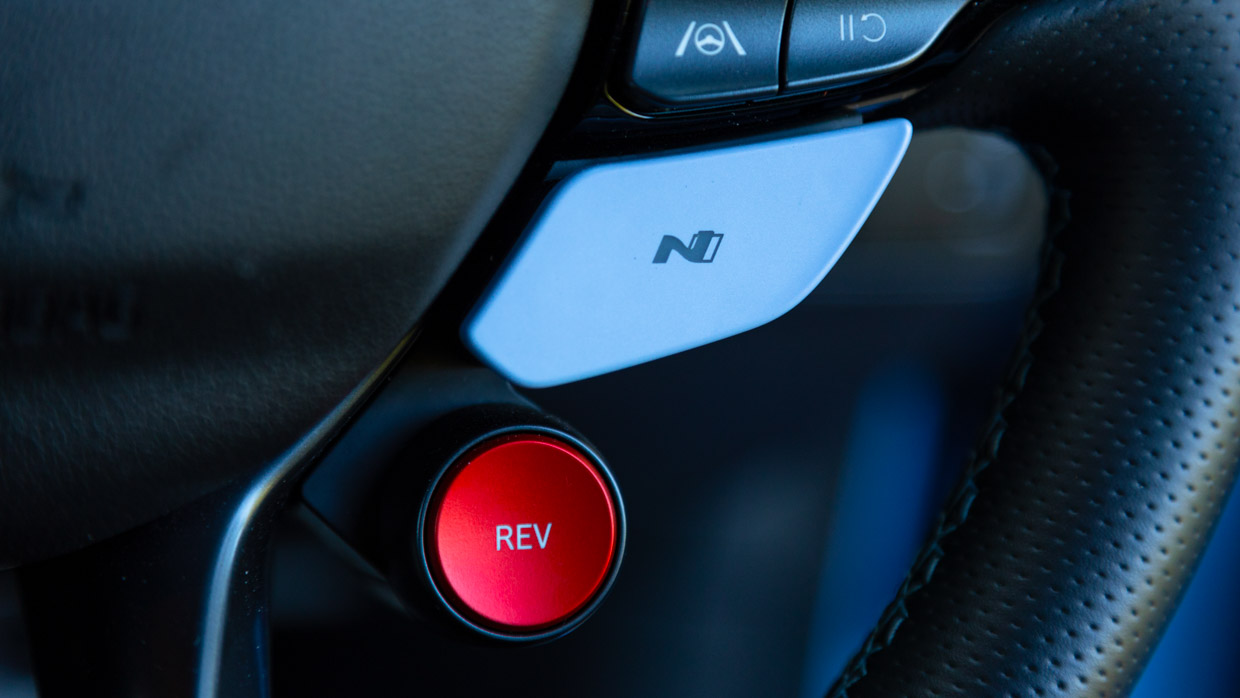
A key setup part are your performance options. Here you can option launch control – although we found it not as quick as human reactions on Noosa’s slippery start line – plus custom settings for engine, stability control and exhaust sound.
Handily for us enjoying a shared drive, there are two different N Custom modes you can quickly switch at the touch of a button. This meant we could nip back to our preferences after each driver swap.
What’s really lovely – and uncommon these days – are your driver assist systems are opt-in rather than opt out. Once you turn them off, they stay off.
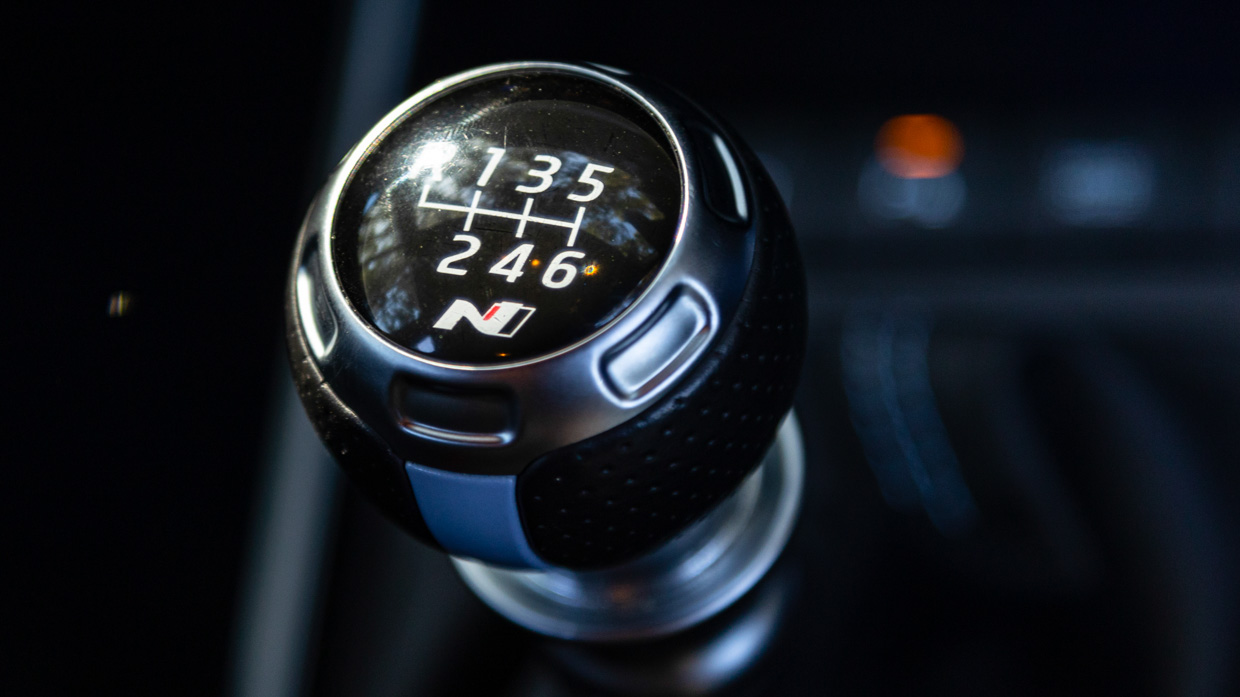
Again appealing to the purist, i20Ns are six-speed manual only. The clutch is light and easy, and the gear shift itself has a nice snickety feel and short throw.
It’s not a life affirming manual shift (an NA Mazda MX-5 and Porsche 911 GTS hold my personal records there), but it’s easy to make rapid changes with the Hyundai’s cog-swapper.
My main grumble is I kept banging my elbow on the side of the seat when moving into sixth. Not a problem at Noosa, where you’ve little need to go beyond third.
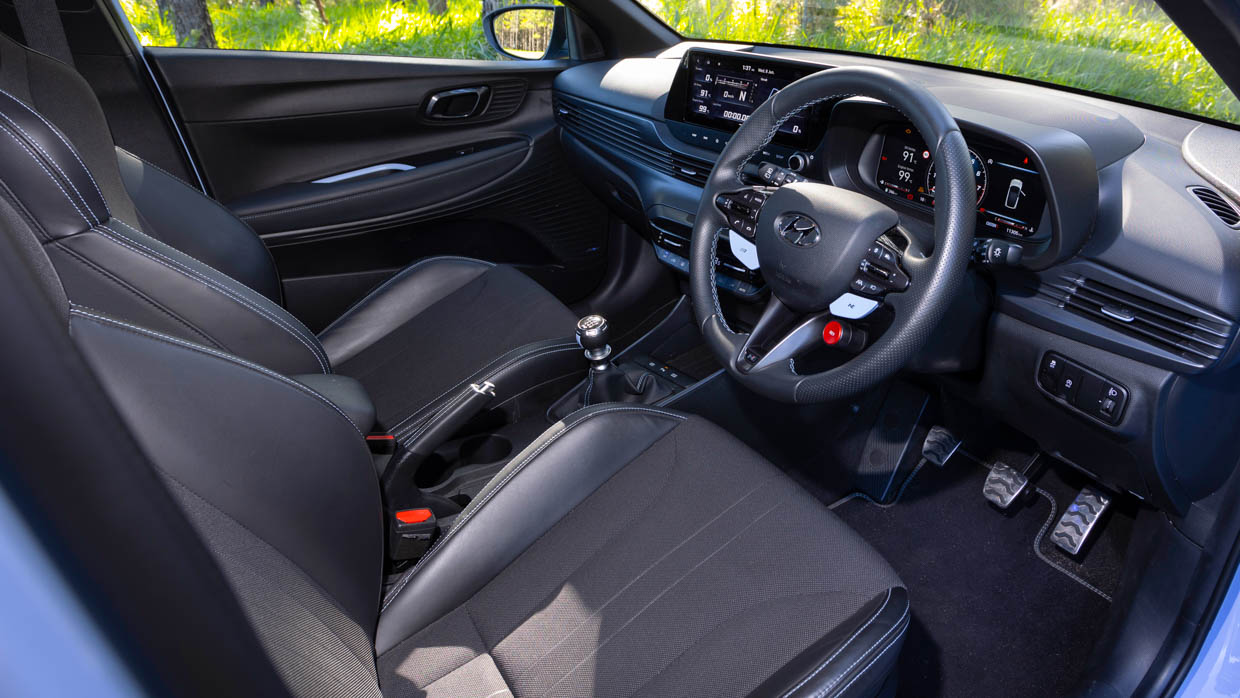
With the exhaust sound set to most antisocial, it’s a raspy, popping, banging, grin-bringer. Off the hill climb start line and it’s a proper screamer, and it’s up into three figures in only 6.2 seconds. It feels light, raw and eager to please, but it really comes alive once you find a bend.
It’s a stiff car and the suspension – which isn’t adjustable – is certainly firm. Good. As previously mentioned, the way the Torsen-style mechanical limited-slip diff helps suck the front end into corners is the revelation.
Get your braking out of the way, turn in at a silly speed, and it rotates in a brilliantly communicative way. Just like my old Peugeot 205 GTi, the inside rear wheel pops up in the air, and you just hope there’s a photographer there to catch it.
You can then plant the throttle and it just sticks, heading exactly into the apex where you point the steering wheel. It shouldn’t be this easy.
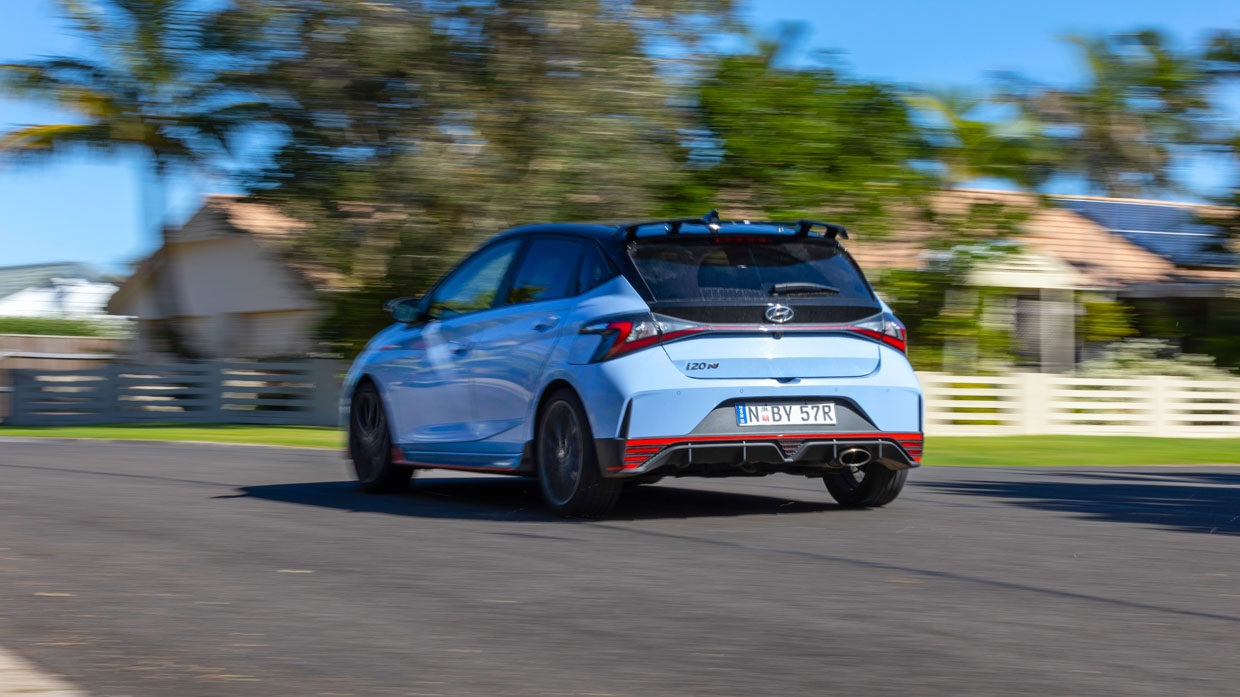
There’s enough body roll to help the driver feel the movement, making it feel less likely to do something unpredictable and snap out towards a wall.
I had only the one spikey moment (see intro) but I blame cold tyres and over-eagerness to better my time against the clock.
You come away exhilarated. Joyous. Confident that you can go and do it again and the car will always be on your side. And, as we found, it can manage a damn good time as well next to some very competent rivals.
While many at Noosa Hill Climb have the arduous task of getting their cars on a trailer for driving home, we just take the i20N’s stickers off, check tyre pressures and hit the road.
I understand John Law’s observations that it’s a stiff car to live with every day, but I know I’ve suffered worse – Peugeot 308 GTi 270 and JCW Mini Cooper immediately spring to mind. The i20N’s at-the-limit abilities certainly offer ample compensation.
On the highway at 110km/h it sits at 2700rpm, there’s tyre noise and wind noise, but there’s also Bose audio to help drown it out. See, the i20N – when it rewards as it has at Noosa Hill Climb – makes it easy to find excuses for its compromises.

What’s more, it’s a little car that most seem to love. Many at the hill climb came to ask about the Hyundai after seeing its climb times, keen to know about its engine, very clever chassis and how much they are.
Little wonder there’s a cult following for these i20Ns, and there are a few bolt-on items available for better suspension range, plus a variety of different tyres should owners want to move to the next level.
Not that it’s really needed. Here’s a hot hatch in the true tradition of the formula, right off the showroom floor. Cheap, light, raw, raspy and just damn good fun. Your biggest problem is getting hold of one.
Variant tested N
Key specs (as tested)
About Chasing cars
Chasing Cars reviews are 100% independent.
Because we are powered by Budget Direct Insurance, we don’t receive advertising or sales revenue from car manufacturers.
We’re truly independent – giving you Australia’s best car reviews.
The estimate provided does not take into account your personal circumstances but is intended to give a general indication of the cost of insurance, in order to obtain a complete quote, please visit www.budgetdirect.com.au. Estimate includes 15%^ online discount.
^Conditions Apply
Budget Direct Insurance arranged by Auto & General Services Pty Ltd ACN 003 617 909(AGS) AFSL 241 411, for and on behalf of the insurer, Auto & General Insurance Company Limited(ABN 42 111 586 353, AFSL 285 571).Because we don’t know your financial needs, we can’t advise you if this insurance will suit you. You should consider your needs and the Product Disclosure Statement before making a decision to buy insurance. Terms and conditions apply.
Indicative quote based on assumptions including postcode , 40 year old male with no offences, licence suspensions or claims in the last 5 years, a NCD Rating 1 and no younger drivers listed. White car, driven up to 10,000kms a year, unfinanced, with no modifications, factory options and/or non-standard accessories, private use only and garaged at night.
^Online Discounts Terms & Conditions
1. Discounts apply to the premium paid for a new Budget Direct Gold Comprehensive Car Insurance, Third Party Property Only or Third Party Property, Fire & Theft Insurance policy initiated online on or after 29 March 2017. Discounts do not apply to optional Roadside Assistance.
2. Discounts do not apply to any renewal offer of insurance.
3. Discounts only apply to the insurance portion of the premium. Discounts are applied before government charges, taxes, levies and fees, including instalment processing fees (as applicable). The full extent of discounts may therefore be impacted.
4. We reserve the right to change the offer without notice.